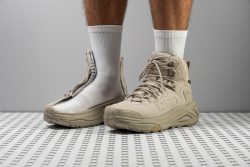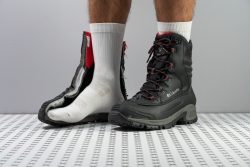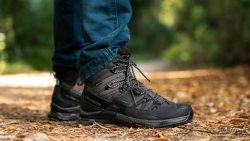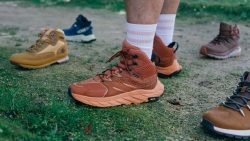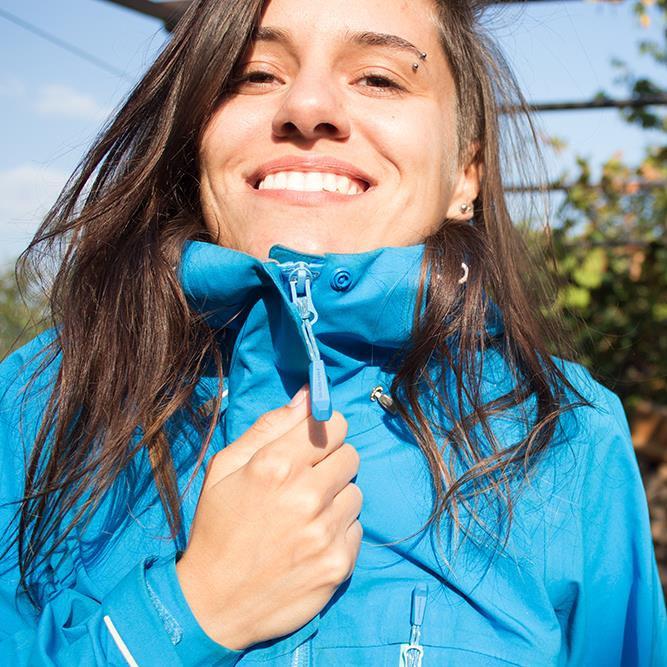2 Best Hiking Boots For Plantar Fasciitis in 2025
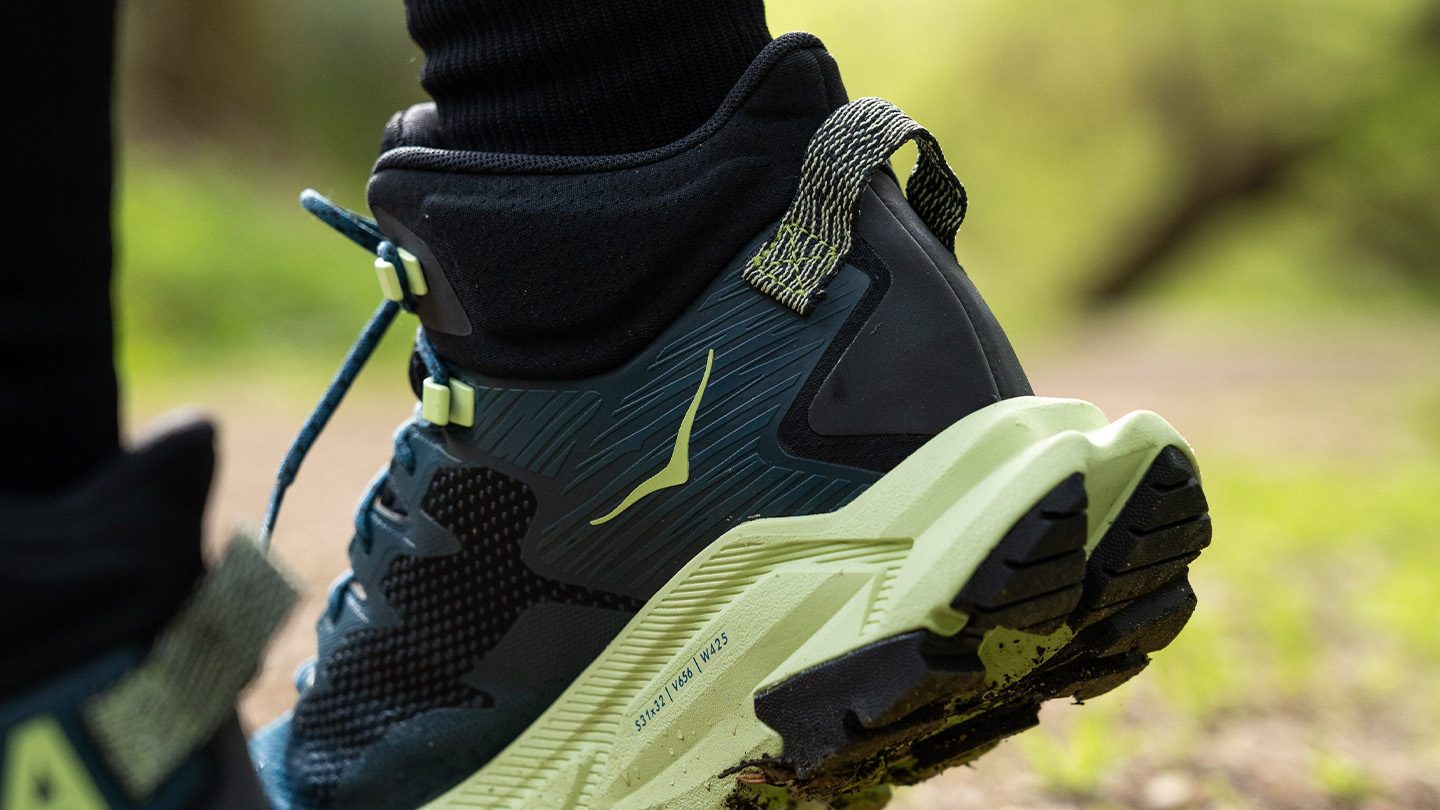
We buy shoes ourselves. We earn commissions when you buy through us, at no extra cost. Why trust us
It usually starts with heel pain. It can be sharp from the first moment or progress to the higher intensity and sharpness. Nevertheless, plantar fasciitis is not something to play around with.
In this guide, we cover the features of the hiking boots that usually feel good when your heel is in pain and needs to be stabilized. It's all about stabilization and preventing wobbling and any unnecessary extra movements, however small they are.
We always recommend a) resting and b) visiting a specialist. Maybe your heel pain is not caused by plantar fasciitis? If you already know you've got PF, welcome! Enjoy our guide and our top picks in different categories.
How we test hiking boots for plantar fasciitis
We prioritize objectiveness and transparency. Because of that, we:
- Buy all the hiking boots with our own money;
- Test the boots on our hikes, in wet and dry terrain, on uphills and downhills, easy and technical trails;
- Subject the boots to various lab tests which result in 20+ data points that accurately describe the fit, shock absorption, performance and durability of each boot;
- Publish all our results, along with the averages for the given category and together with other results so that you can compare the boots of your interests by any parameter;
- Choose the top picks based on our experience with the boot on the hikes and based on our lab data.
Best hiking boots for plantar fasciitis overall
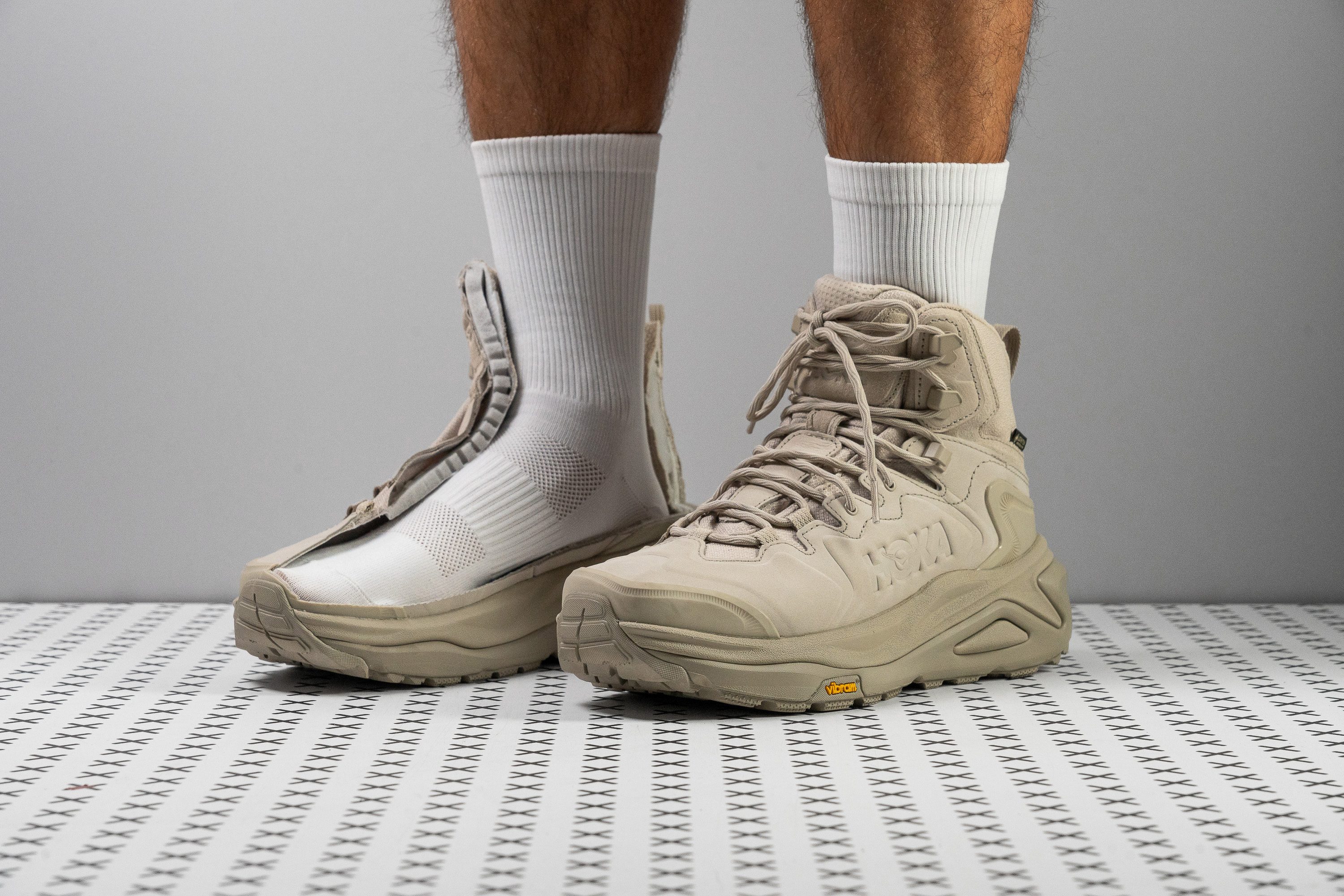
















































What makes it the best?
The Hoka Kaha 3 GTX offers the perfect formula of comfort and stability in our trail adventures, which makes it the best boot for hikers with plantar fasciitis. It combines a sturdy structure with exceptional muscle protection, which our lab tests validate.
The platform feels well-protected from underfoot debris and impact, but feels well-balanced. It features a dual-density foam that boosts our surefootedness and supports our arches and heels very well. Each landing is barely felt because the foam itself absorbs impact very well, verified by its above-average 120 SA score.
Our ankles never collapsed as we walked through uneven trails. Both the heel counter and rigid midsole had no give, which prevents us from buckling over or twisting our ankles, so we awarded them with the maximum 5/5 stiffness rating.
The Vibram Megagrip offers confidence-inspiring grip, backed by its 0.65 score in our traction test. It features 3.2 mm lugs, making it versatile for rocky and hard-packed terrain. However, they aren’t sharp and deep enough for mud and soft ground. Hikers who frequent such trails should find more aggressively grippy boots.
Pros
- One of the best cushioned boots ever
- Extremely comfortable for long miles
- Highly stable and supportive
- Excellent traction on smooth surfaces
- Grips mixed and hilly terrain well
- Contains sustainable materials
- More streamlined than the Kaha 2
Cons
- Lugs got much shallower
- Heavier than average
Best winter hiking boots for plantar fasciitis
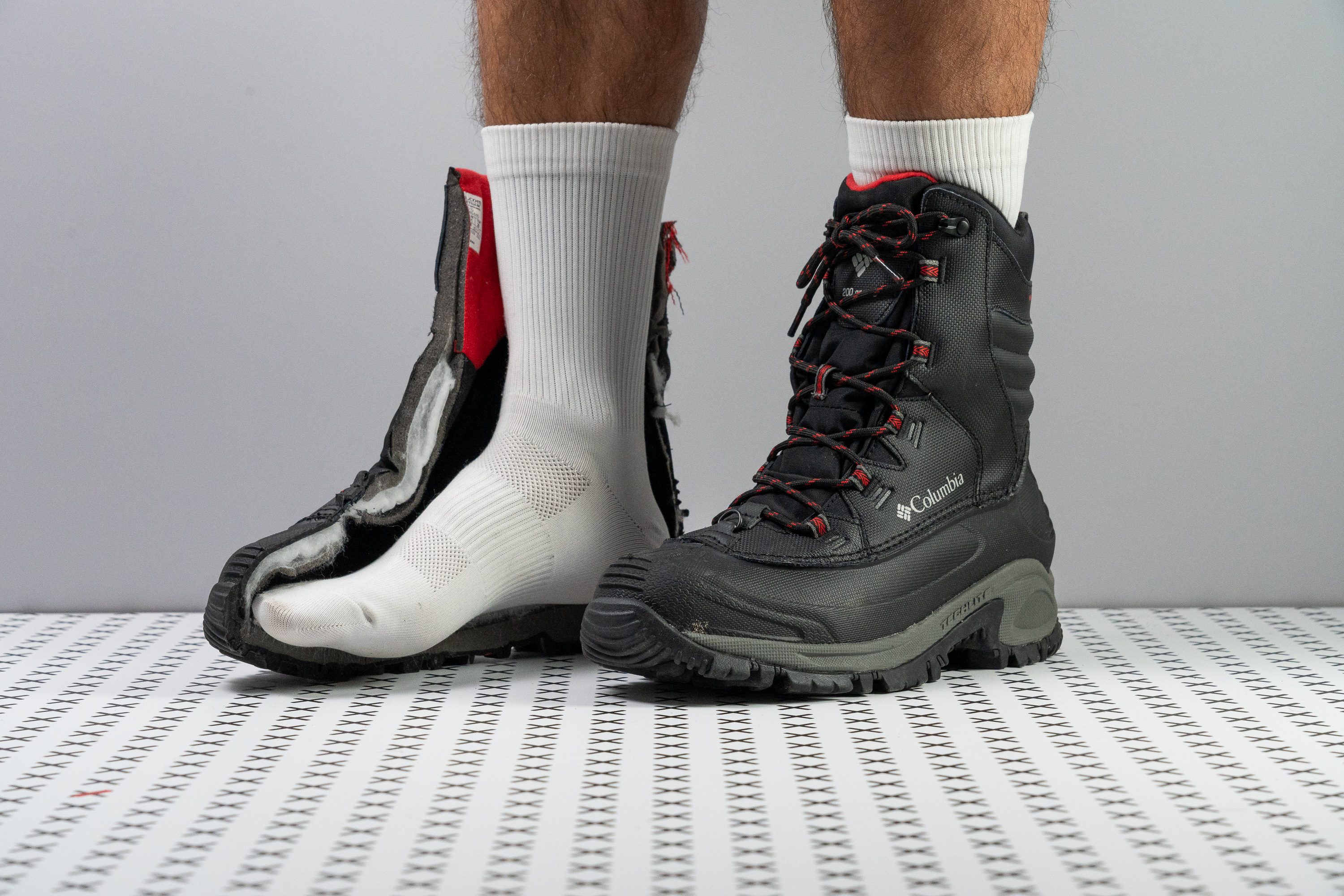































What makes it the best?
The Columbia Bugaboot III feels like home, with its warm embrace and cushioned base keeping our legs and our souls happy. Lab tests reveal its generous height and joint protection are supported by a grippy outsole, giving us steady footing. Yet its impermeable upper is what seals the deal in making it our best winter plantar fasciitis hiking boot.
We put the leather upper in our smoke test, and the air we pumped in had no room to escape. We gave it the lowest 1/5 breathability score, making it our perfect companion for sub-zero temperatures.
The outsole felt so reliable, even as we trekked through melted snow and frozen surfaces. We measured the lugs to be 5.7 mm, 1.4 mm deeper than average, and proving its solid bite in various trails we set foot on.
The midsole offers abundant cushioning and protection, which helps relieve our muscles. The stack height is massive, reaching 46.9/30.7 mm, with a high shock absorption score of 114 SA. The platform really felt supportive, especially since the steep 16.2 mm drop took the load off our heels.
Unfortunately, like all our winter clothes, this boot is very bulky. At 26.0 oz (737g), it’s 38.8% heavier than the average boot. Those seeking agility won’t find it here.
Pros
- Jaw-dropping comfort
- Remarkable insulation
- Watertight upper
- Excellent durability
- Plenty of cushioning
- High level of support
- Reliable grip
- Affordable for its kind
Cons
- Restrictive toebox
- Heavier than average
This guide is here to educate, not offer medical advice.
Heel pain and plantar fasciitis
Most hikers discover plantar fasciitis when they feel a sharp pain in their heel. This pain basically alerts us that our plantar fascia is inflamed. The plantar fascia is a thick band of tissue at the bottom of the foot that connects the ball of the foot and the heel, creating the arch. Inflammation happens when the fascia is overused or overstretched.
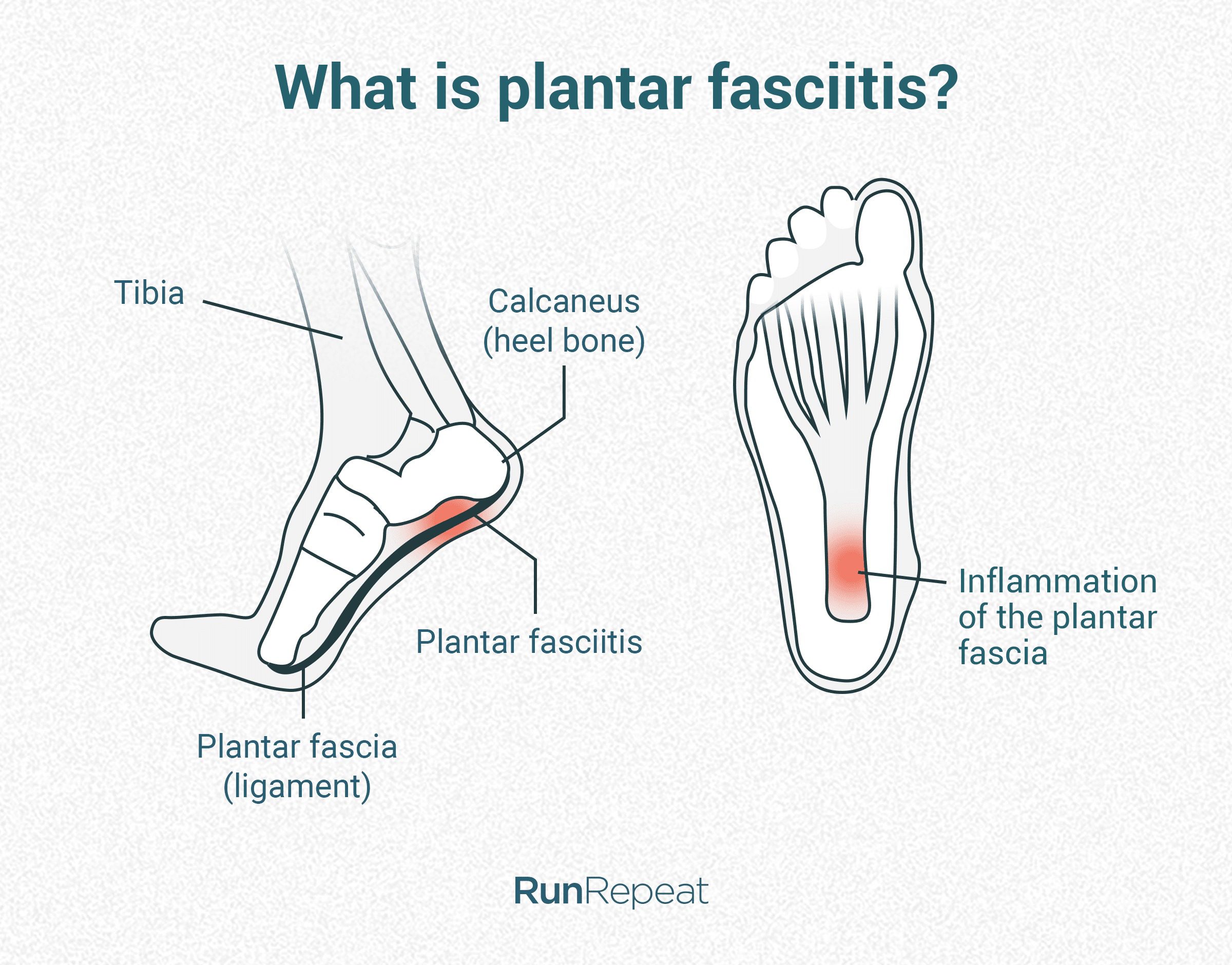
This heel pain is not easy to ignore, and it’s best to consult a specialist before taking any other action besides resting. If you try to hike through the pain, maybe using NSAIDs, the condition can get worse. After all, plantar fasciitis is not the only cause of heel pain.
As with any other foot condition, it’s best to get properly diagnosed and make a rehabilitation plan. Different footwear can help, up to a certain degree. When talking about hiking boots, we focus on features that offer a superb lockdown and a rigid platform. This allows the overworked fascia to work only as much as needed, not more.
Look for these 5 hiking boot features if you’re dealing with plantar fasciitis
Imagine you’re hiking on a terrain covered with large sharp rocks. The moment you step on a sharp edge, your boot can bend/twist with your feet following that platform movement as much as they can, or your boot can be stiff and stay leveled, just like your foot. When dealing with plantar fasciitis, we’re looking for the latter.
Basically, we want to remove all the unnecessary strain that could be placed on the plantar fascia. We do this by not allowing the foot to twist too much, by locking the heel firmly in place, and by having the heel elevated (here, we’re talking about the heel drop). Based on this, we recommend you look for:
- Cushioned hiking boots and not minimalist/barefoot ones. Look for a shock absorption of at least 85 SA.
- Heel drop of at least 8 mm. The heel drop goes from 0 (or close to zero) to above 20mm. High heel drop utilizes the higher-leg muscles so the plantar fascia is not overused.
- Rigid platform. As explained above on the example when a hiker is stepping on a sharp rock, it’s best to have a platform that won’t allow your foot to struggle to find balance, but always be planted.
- Moderate-to-firm platform. Too soft and your feet will be sinking in and working to “come back up”. We can prevent that by not choosing too-soft platforms.
- Stiff heel counters that will keep the heel in place.
We will cover each of these features (and more) below.
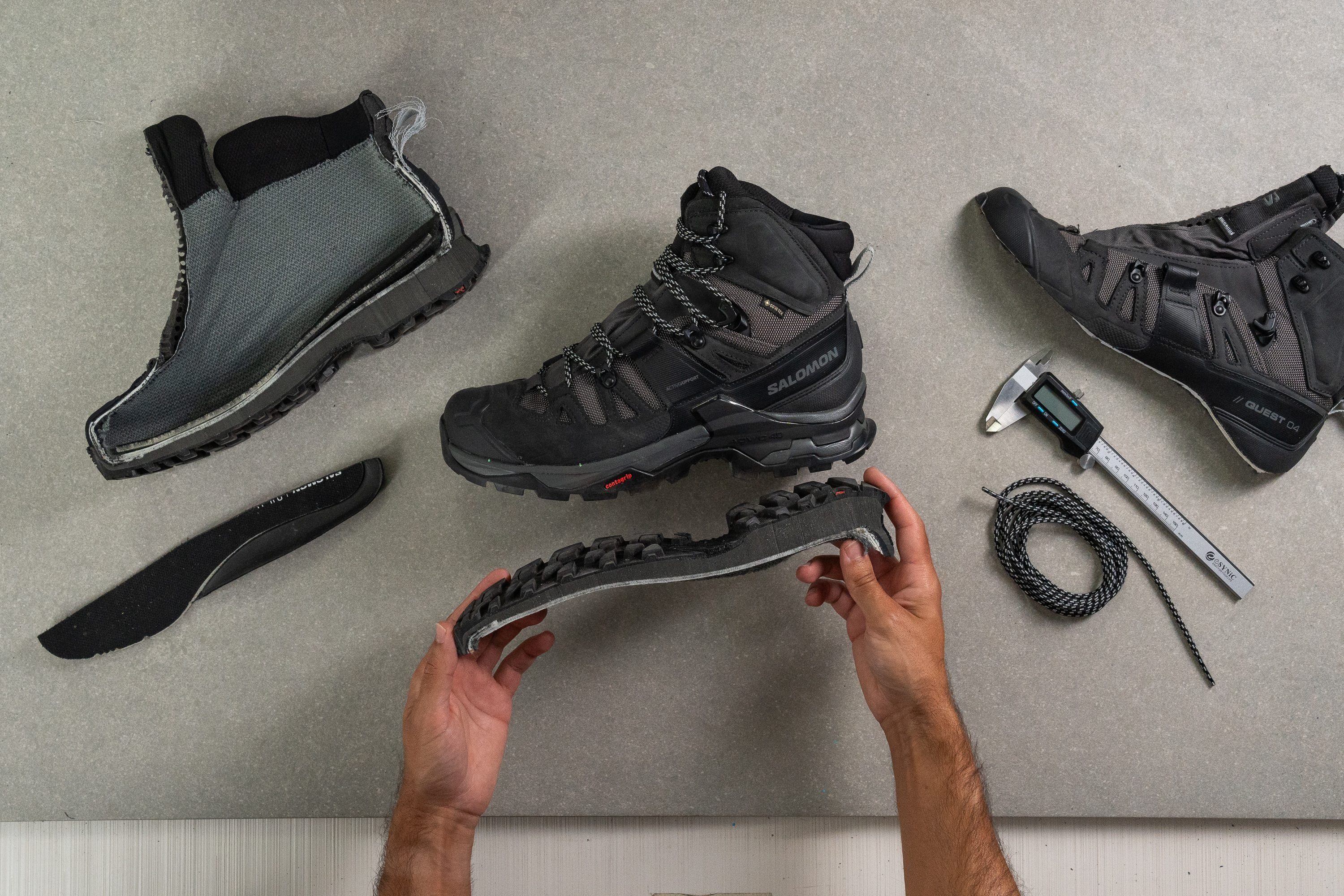
Skip minimalist/barefoot hiking boots if you have plantar fasciitis
While barefoot and minimalist footwear have their own advantages, like strengthening the foot muscles, feeling the ground, and moving “naturally” in insanely flexible hiking boots, all of those advantages are disadvantages for hikers who have plantar fasciitis.
We want to cushion the heel so that it absorbs less impact. For plantar fasciitis, we recommend hiking boots with a shock absorption of at least 85 SA.
High-drop hiking boots can bring some relief
Heel-to-toe drop is the difference in height between the heel and the toes (forefoot). That’s exactly how it is calculated: heel stack height minus forefoot stack height. Why is the heel drop so important? Because it can affect our leg muscles differently and we should be mindful of the possible effects.
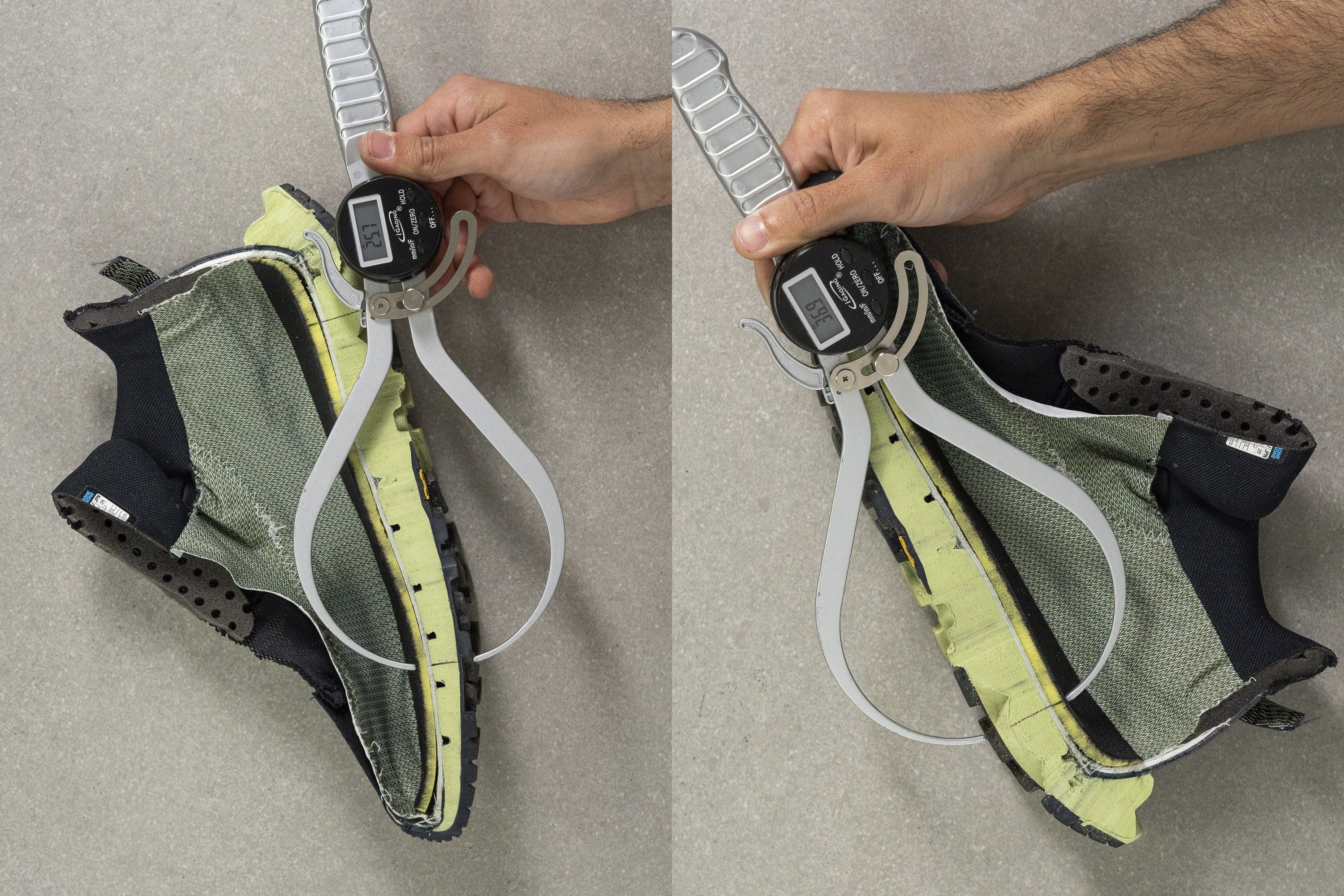
We split hiking boots into 4 groups based on their heel drop:
- Zero-drop hiking boots: the heel and the toes are on the same level. These boots make the foot muscles work the most and are often used for strengthening of those muscles.
- Low-drop hiking boots have a heel drop of 1-4 mm. They utilize the lower leg muscles, Achilles, calves.
- Mid-drop hiking boots have a heel to toe drop in the 5-8 mm range. They usually put more stress on the knees and thighs.
- High-drop hiking boots have a heel drop higher than 8 mm and they activate the higher-leg muscles the must, especially the hip muscles. These boots are the best for hikers dealing with plantar fasciitis as we know they don’t put extra stress on the plantar fascia.
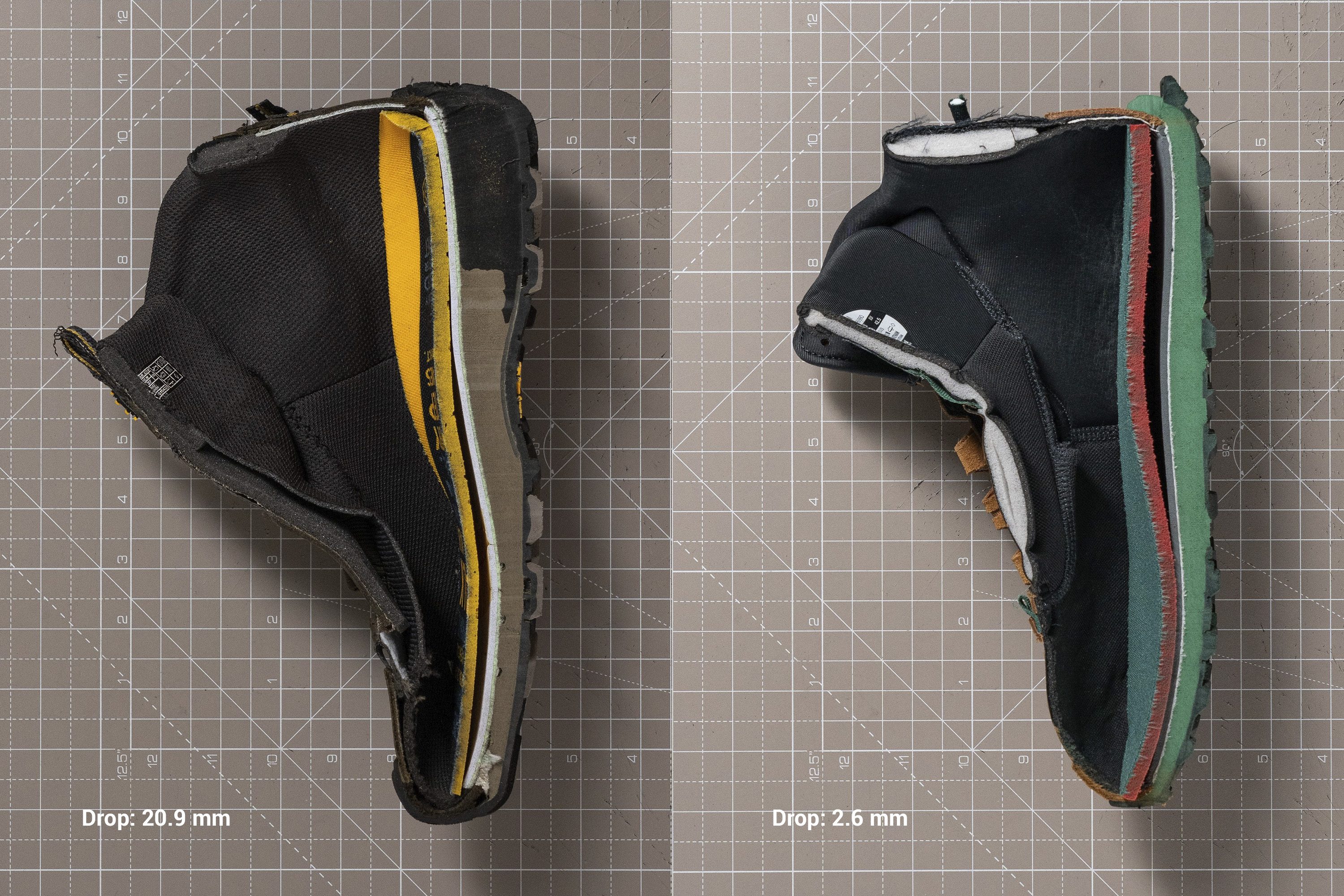
For context, here are some averages pulled from our lab database:
- Average heel drop of trail running shoes: 7.6 mm
- Average heel drop of hiking shoes: 11.1 mm
- Average heel drop of hiking boots: 13.8 mm
How to find a rigid hiking boot for plantar fasciitis?
There are 2 ways to do this: if you’re shopping for hiking boots in specialized stores, twist the boots. Look for those that resist the twisting the most. Or, if you’re looking for a boot on RunRepeat, find one that scored 3, 4, or 5/5 on our torsional rigidity test.
This hiking boot scored 5/5 on our torsional rigidity assessment, meaning it is as rigid as it gets
This hiking boot scored 2/5 on our torsional rigidity assessment, meaning it is flexible
As mentioned above, this stiffness helps stabilize the foot, especially on uneven terrain. This means our plantar fascia won’t be forced to compensate for the small movements needed when hiking in non-rigid boots.
Fortunately, the average torsional rigidness for hiking boots (per our current lab data) sits at 4.3/5.0, so the boots are stiffer on average than, say, hiking shoes and trail running shoes.
In our lab, we also measure the longitudinal stiffness.
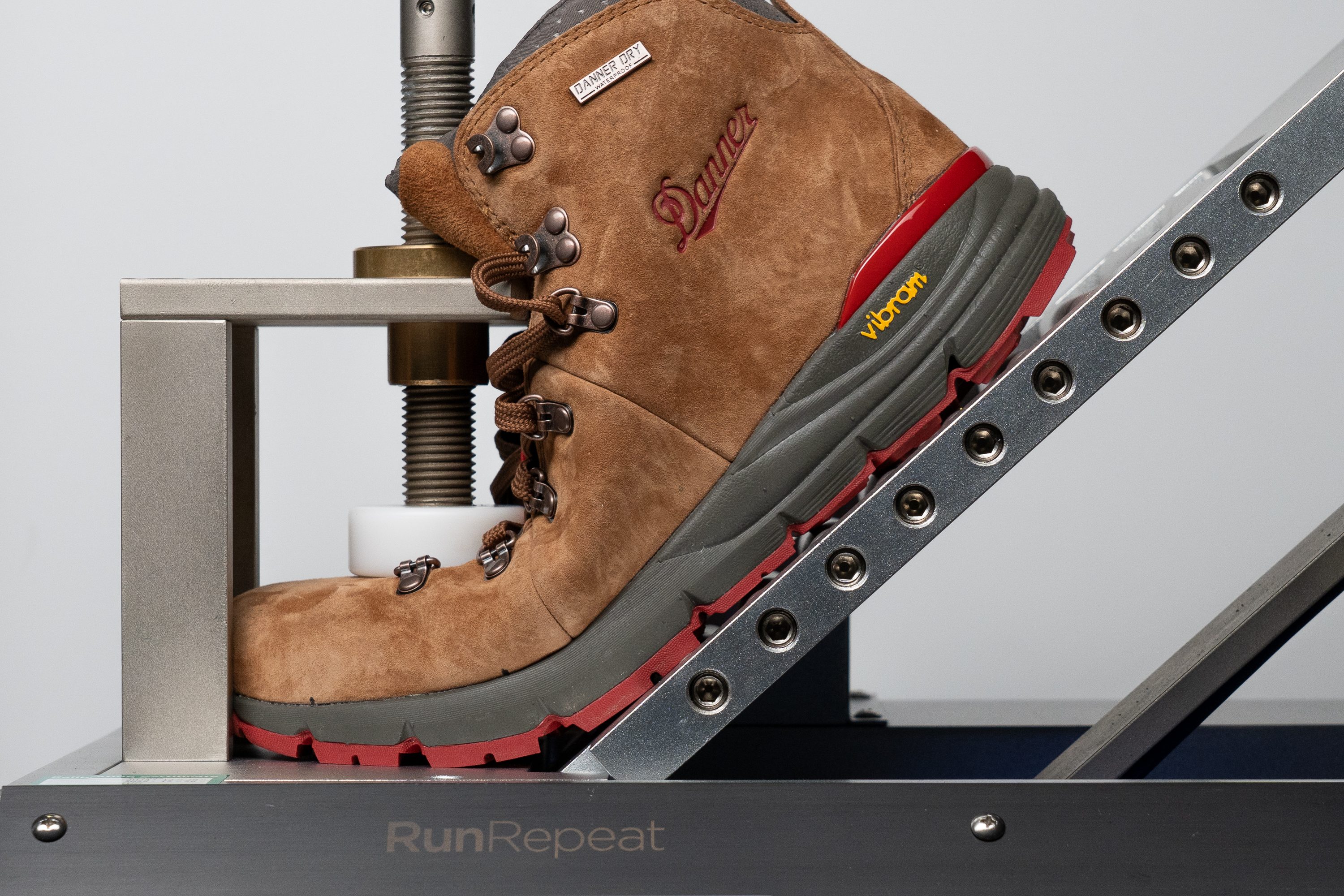
You can always consult our lab results if this metric piques your interest as well.
Say no to soft platforms when dealing with plantar fasciitis
Soft midsoles feel awesome! Usually. To most hikers. Even “recovery slides” can be found on the market which are soft and all about cloud-like experience. However, hikers with plantar fasciitis might not enjoy such underfoot.
Maybe at first, the softness will be good. But, in the long run, or during a longer hike, softer platforms make our feet work more. They make it easier for our feet to sink in and shift slightly to the sides (wobble). All of these micromovements put additional strain on the plantar fascia. And that’s exactly what we want to avoid.
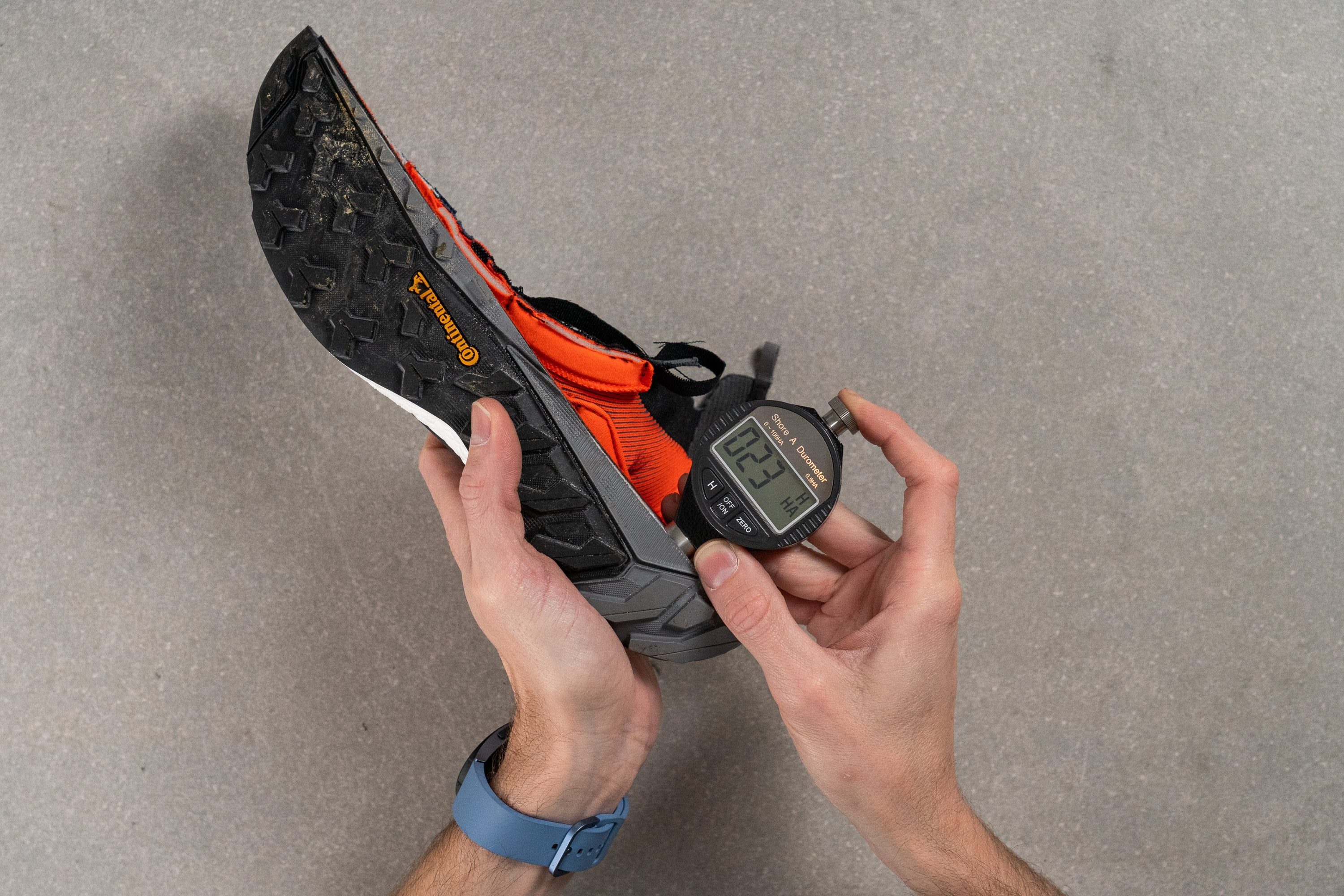
Based n our experience, we recommend midsoles that are not too soft or that show a minimum of 20 HA on our durometer.
Stiff heel counters: how to recognize them?
Stiff heel counters are the craze for plantar fasciitis! Their stiffness cradles the heels and locks them down in place, which is super important when we want to avoid any unnecessary movements.
You can find out whether the heel counter is stiff by:
- Squeezing it and pushing it (which is what we also do to assess the stiffness). This is valid only if you’re shopping for hiking boots in person.
- Looking at the heel, if it has a plastic heel counter on the outside, it is most likely very stiff!
- Looking at our reviews where we add our stiffness assessments and we cut the boots in half, sometimes the heels have internal heel counters as well, and that’s something we can see only once the boots are cut in half.
Assessing the heel counter stiffness in RunRepeat lab: 1/5 being very flexible and 5/5 being very stiff. The boot in the video scored 3/5
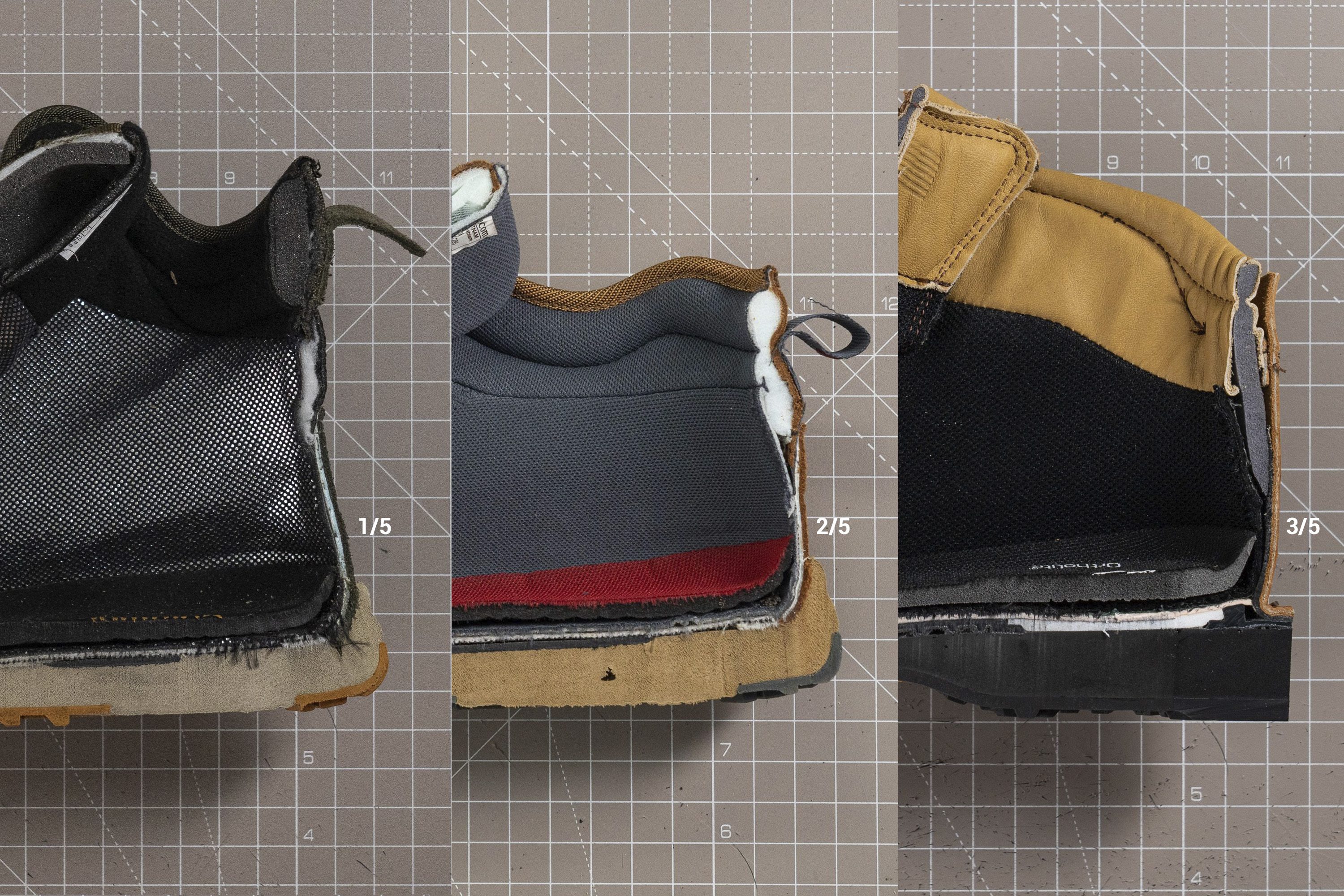
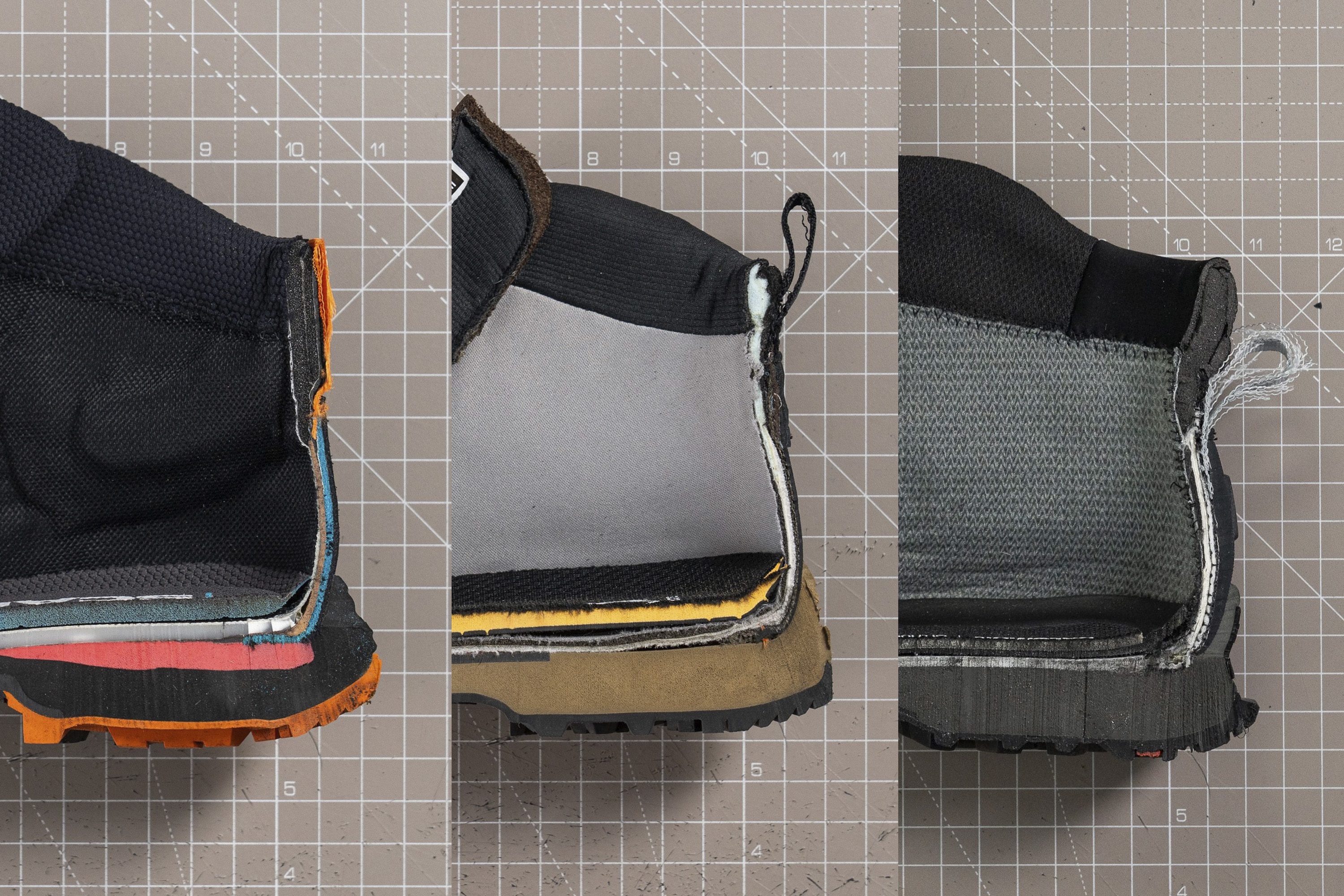
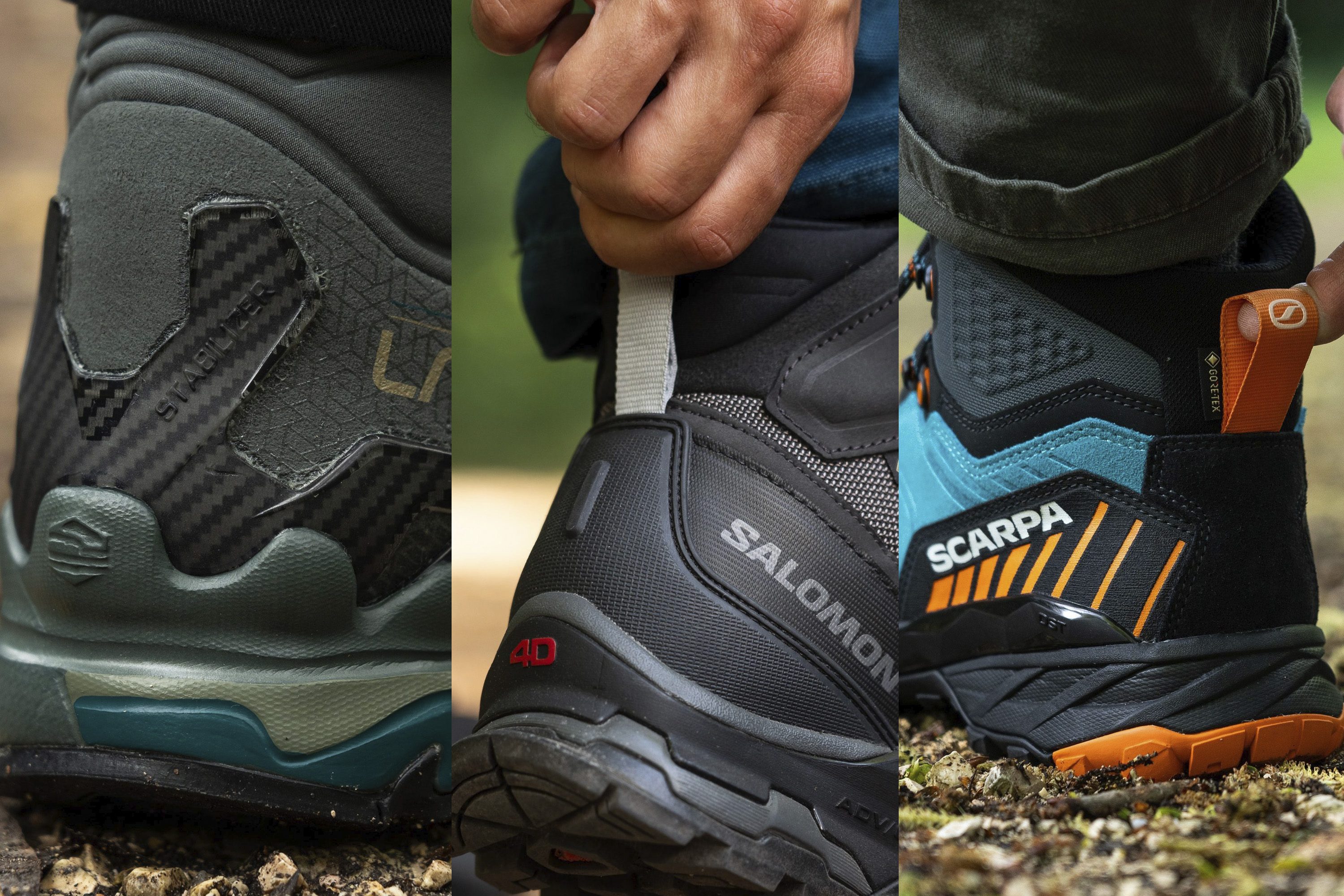
What your heel won’t like
Maybe you’ve found a pair of hiking boots with stiff heel counters, but it does not mean you’ve just won the lottery. When you try the boots on, it’s important that the shape of the heel counter matches the shape of your heel. How to figure that out? If you’re experiencing heel slipping, it’s not a match. If the heel counter is hurting your heel by being too sharp or pointy to the point of creating hot spots, it’s definitely not a match.
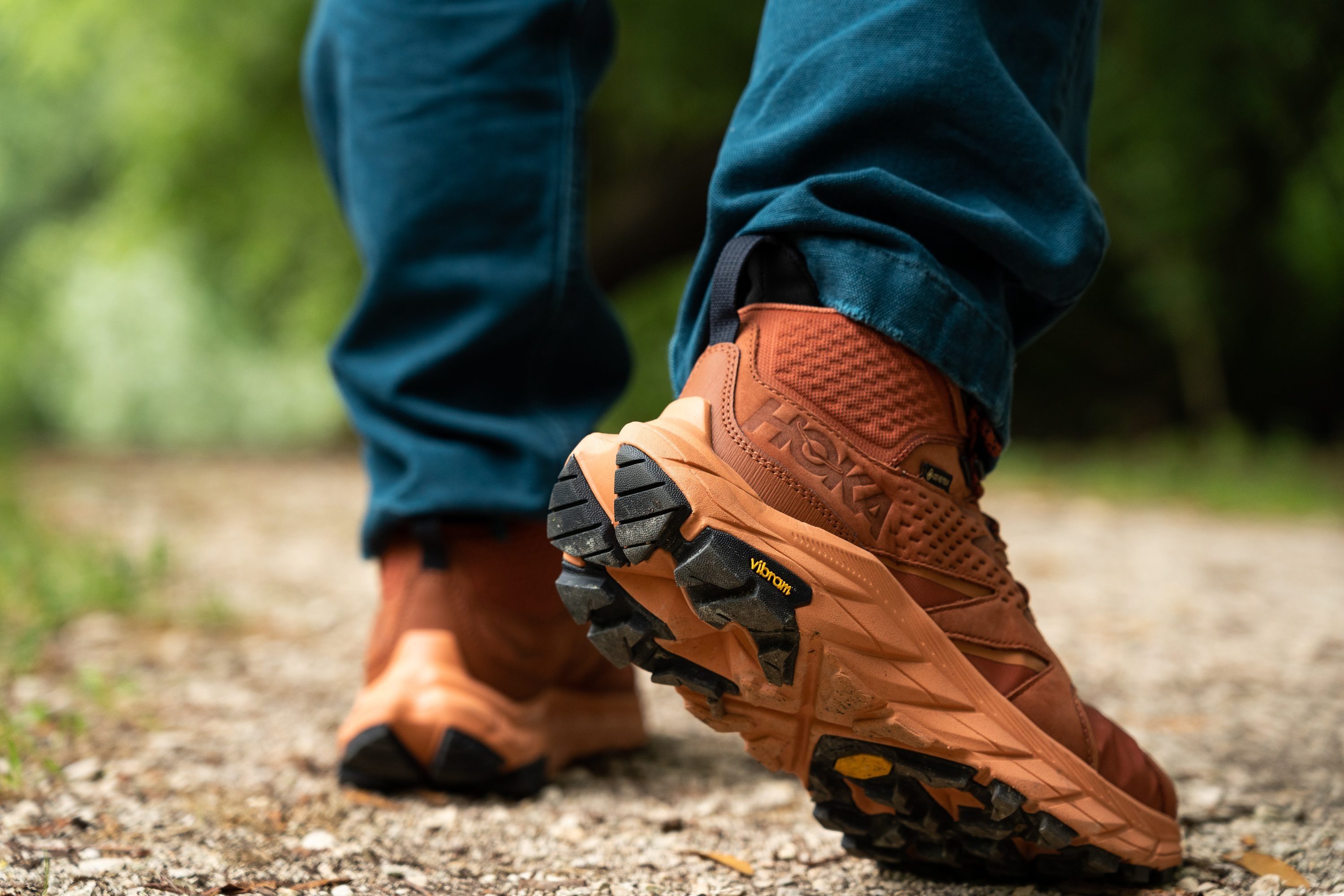
Stiff is ok, but harsh is out of the picture. Look for padded heel counters! Heel counters must not be hurting your heels (even more).
Your heels will appreciate the extra padding
Padding is soft, it brings comfort to our heels, and it prevents bruising and hotspots. It’s easy to spot but, just in case, we will show you a few variations so that you have some context.
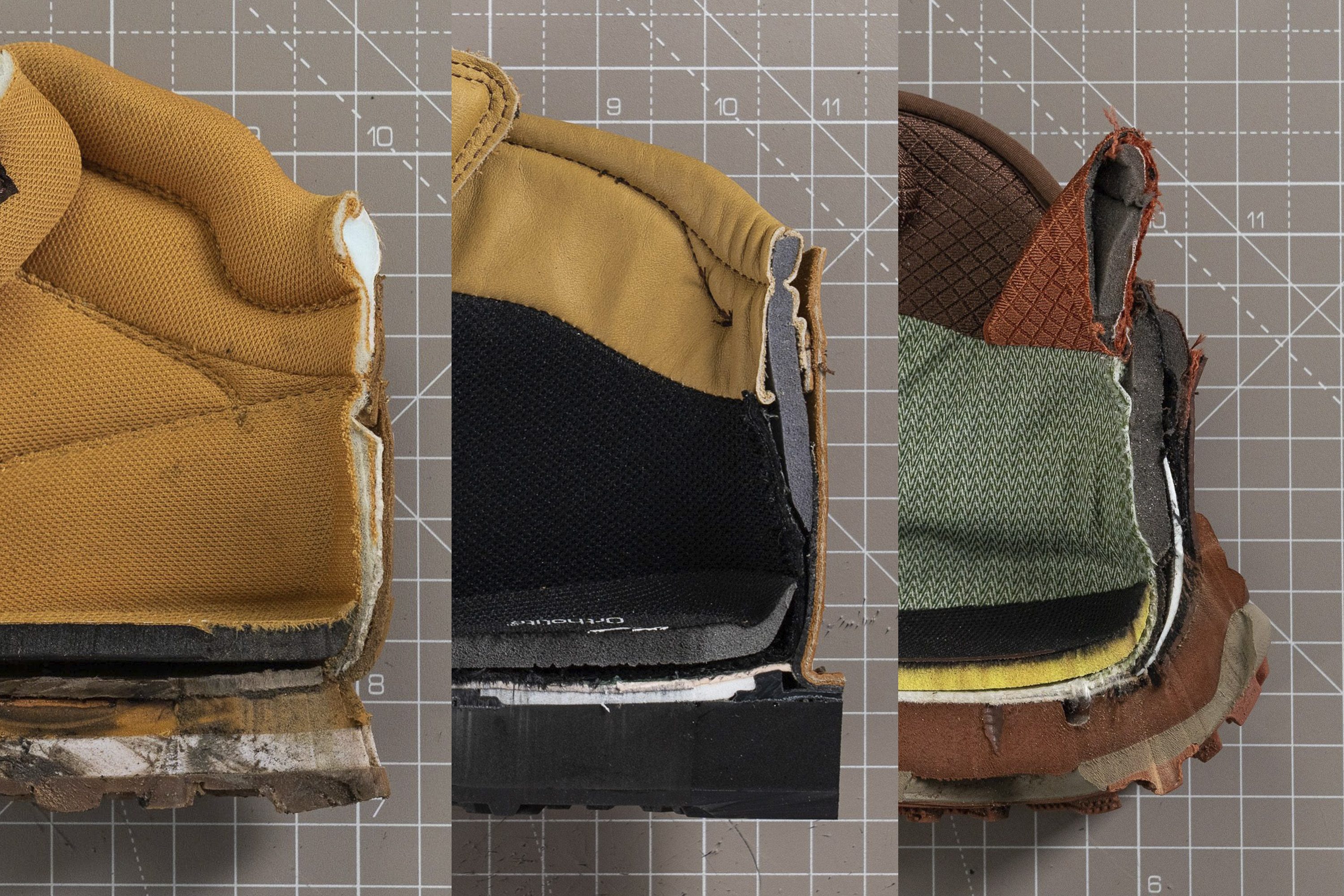
If you get bothered by the pressure on the instep (so-called lace bite), you can also look for more comfort in that area by finding a padded tongue.
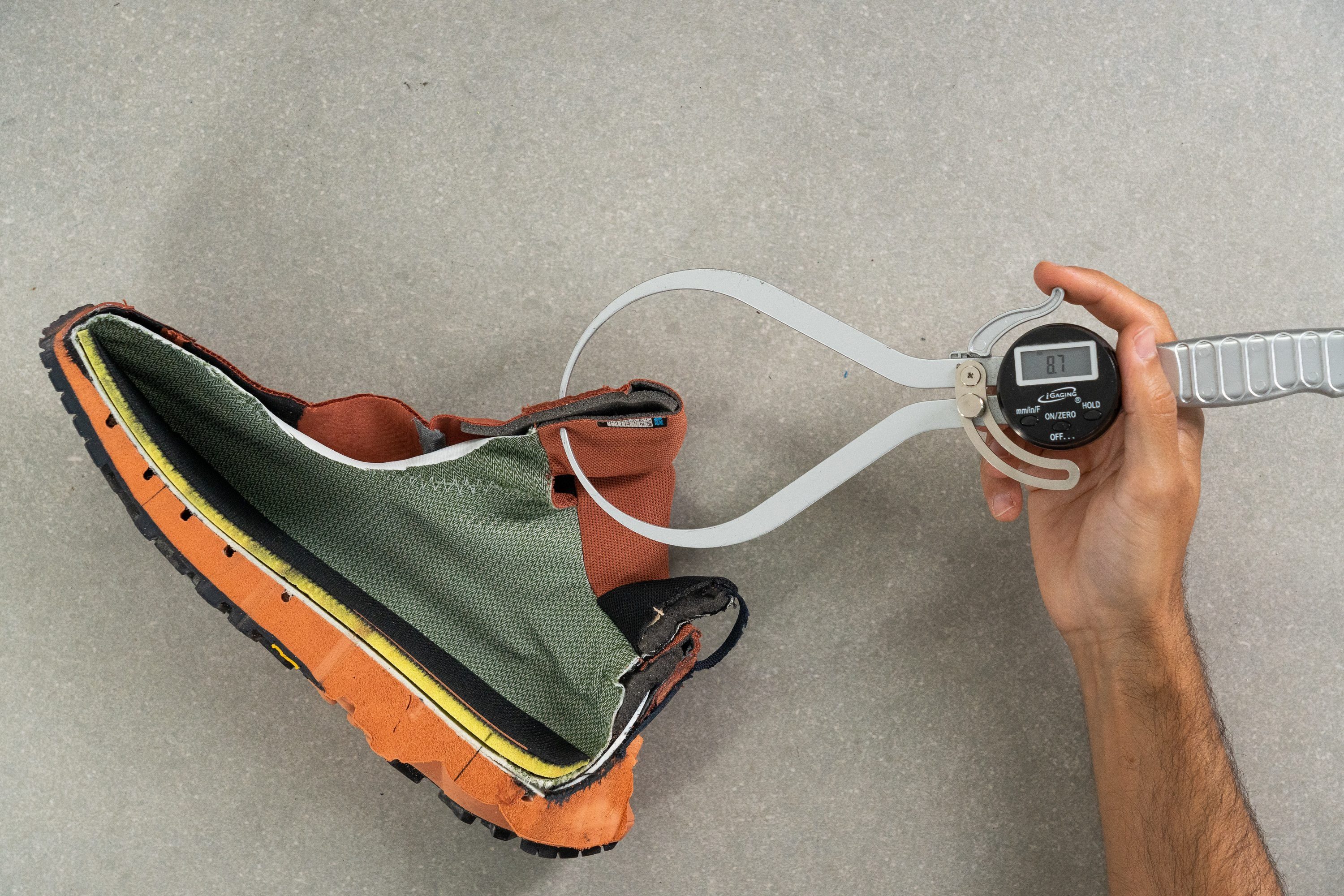
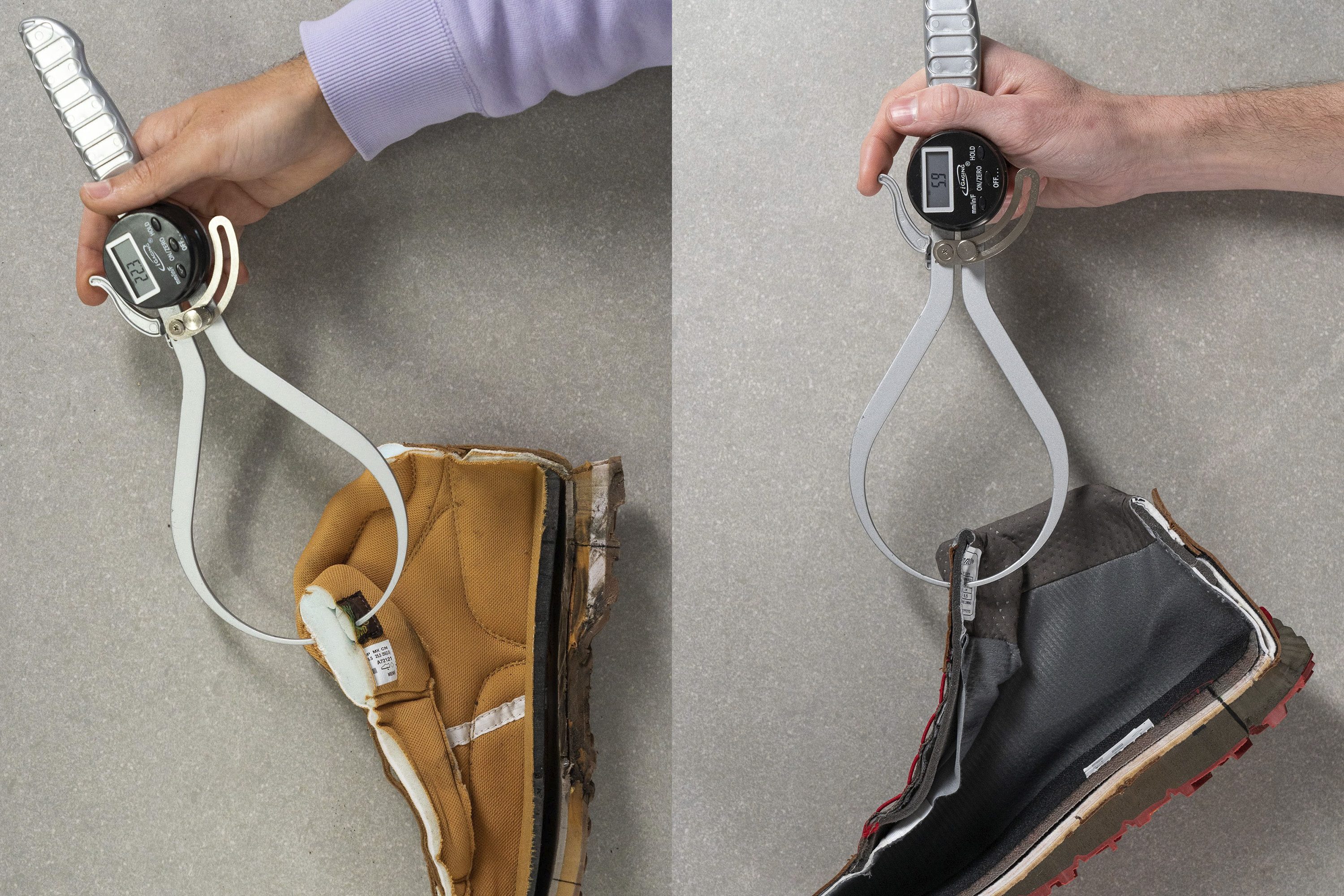
Finding the adequate grip in hiking boots for plantar fasciitis
Finding an adequate grip is always important, regardless of the foot condition you’ve been dealing with. Here’s how we recommend you go about it.
- Decide which terrain and conditions you’re buying the boots for. Wet or dry? Light, moderate, or technical terrain?
- Look at the lugs. Their depth, shape, number, orientation.
- Understand the role the hardness of the outsole plays.
- Check the durability of the outsole, especially if you plan to hike over sharp rocks or similar obstacles that have higher chances of destroying the midsole.
Here’s a quick overview of hiking boot features depending on the terrain difficulty.
|
Hiking boot features depending on the terrain |
|||
|
Feature |
Light |
Moderate |
Technical |
|
Grip |
Shallow lugs <3mm |
Average lugs ~3-4mm |
Very deep lugs >4mm |
|
Protection |
Often without a toe bumper and other protective elements |
A toe bumper is often present; durable leather upper |
The highest level of protection |
|
Durability |
Don’t have to be as durable |
Average durability |
Most durable |
|
Stability |
Often quite flexible. Not to be used with very heavy backpacks. |
Can be both flexible and stiff. Can be used with heavy loads. |
Most stable. Stiff and rigid platform. Great for backpacking. |
|
Weight |
Usually light |
Can be light and heavy |
Usually heavier |
When it comes to the weather, it’s about finding the balance between breathability and, potentially, waterproofness.
|
Upper choices depending on the weather |
||
|
Cold weather |
Warm weather |
|
|
Dry conditions |
For very cold weather, look for hiking boots that scored 1/5 on our breathability test. For cold weather, look for 2/3 or 3/3 and use thicker socks if needed. |
Look for the most breathable hiking boots. Use thin socks, ideally ones with moisture-wicking properties (wool, bamboo). |
|
Wet conditions |
Look for hiking boots with a waterproof membrane. These boots are usually not breathable and get a 1/5 rating on our breathability test. |
Look for hiking boots with a waterproof membrane. They usually score low on the breathability test, so pay attention and see if you can find any that scored at least 2/3 or 3/3. |
Looking at the lugs, we usually talk about their thickness, shape, orientation, and how close or far apart they are placed from each other.
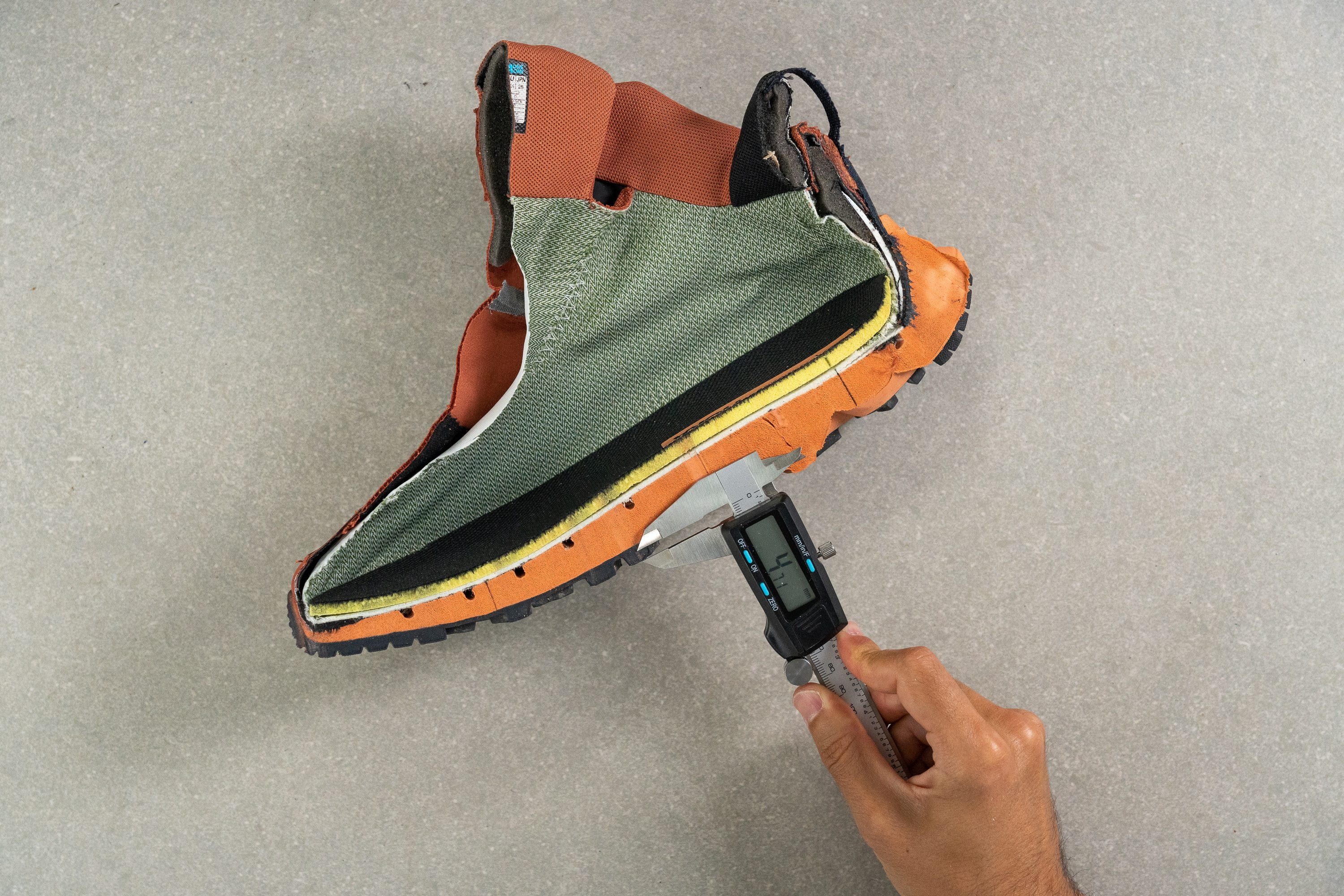
The most general rule is: the deeper the lugs, the better the grip. For mixed terrain with a lot of ups and downs, we recommend 3.5-4.5 mm. Technical terrain asks for the deepest lugs: deeper than 4.5 or even 5.0 mm.
However, that’s not the only thing that we pay attention to. Softer rubber is stickier, while harder rubber is more durable and protective.
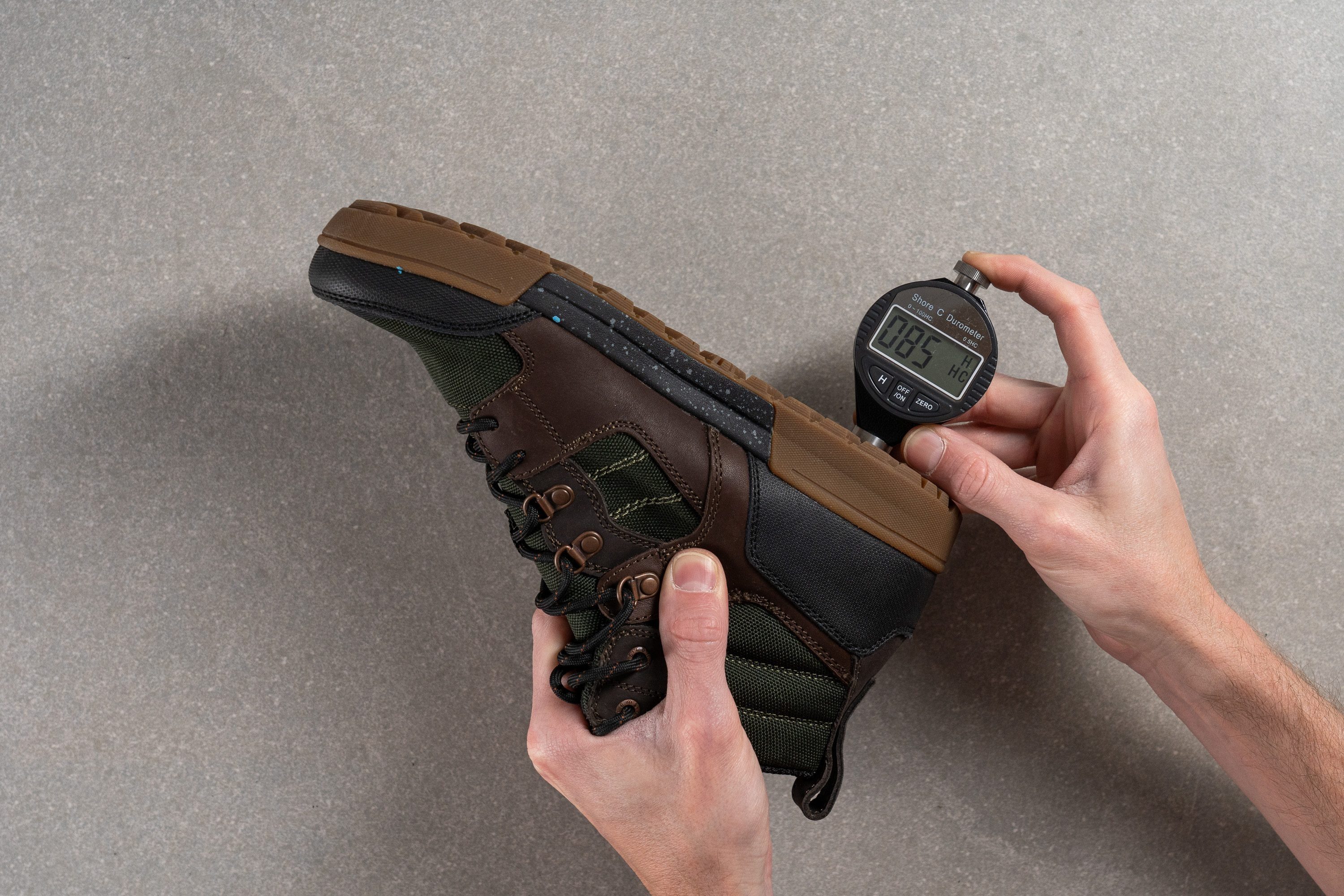
And sometimes, it’s the design of the hiking boot itself that sets it apart, some have very deep lugs but are too chunky to deal with the technical terrain. And, on the other hand, other boots might have shallower lugs but such a sturdy and stable construction that they rock on moderate terrain.
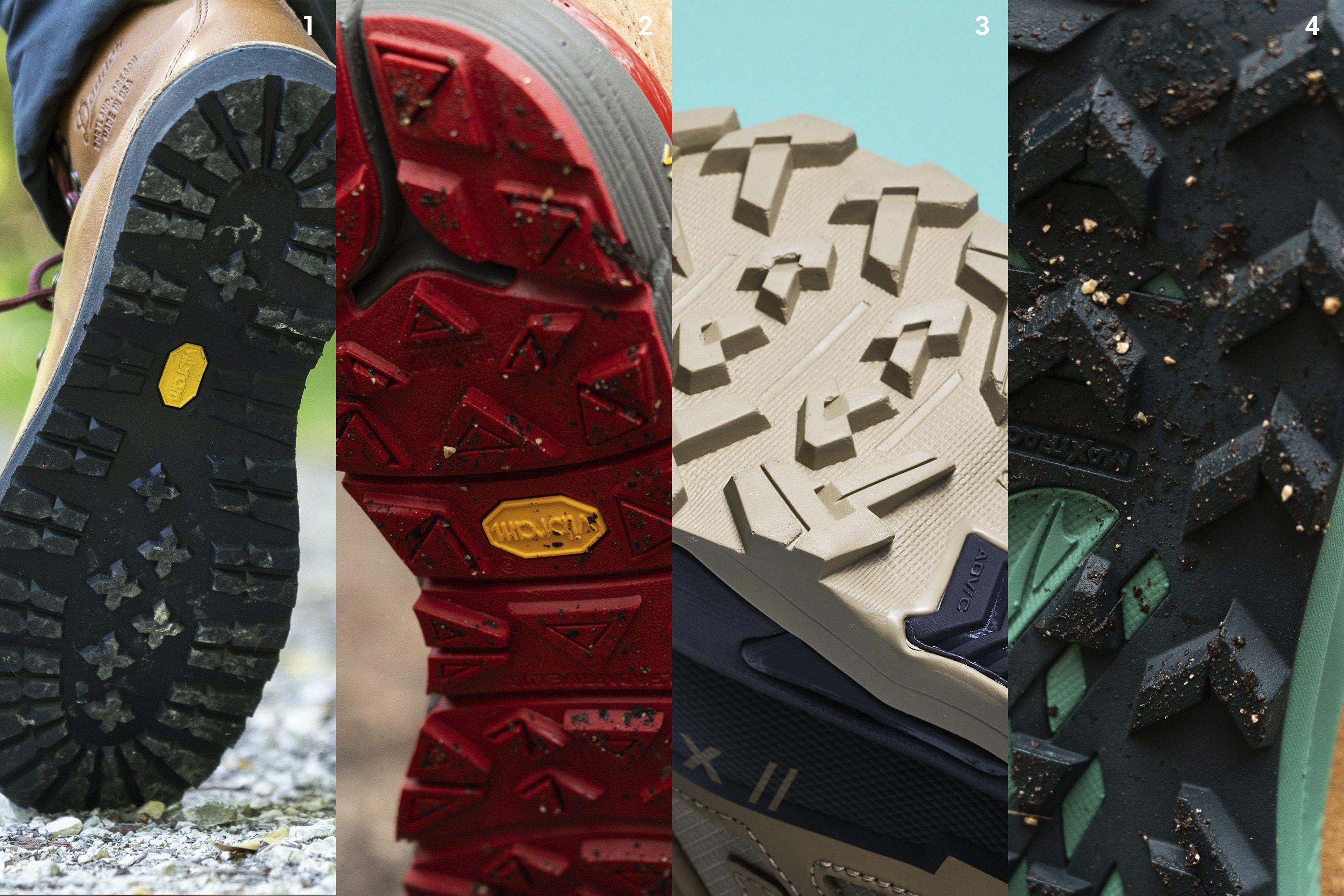
2) Multidirectional lugs in different shapes, spaced not too close to each other, awesome for uphills and downhills
3) Very deep lugs spaced further apart, great for shedding mud
4) Sharp, thick lugs, best for technical and moderate terrain
And, last but not least, we examine the durability of the outsole. This is especially important for hikes who tend to hike on rocky terrain or those who excessively pronate or supinate. They should prioritize durability so that the outsole does not experience premature wear and tear.
Testing the durability of the outsole on hiking boots: the shallower the dent, the more durable the outsole

